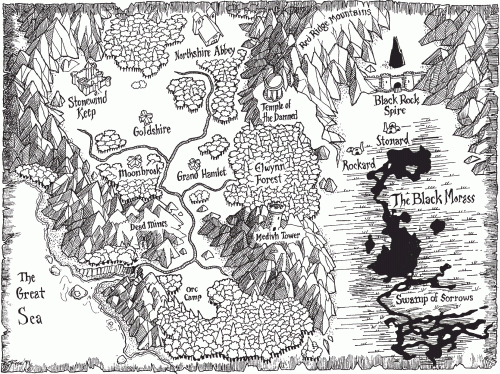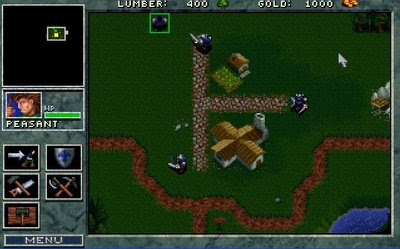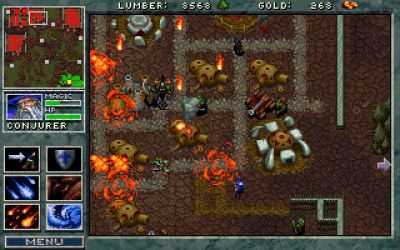Creating Warcraft (Part 2)
From translator
 The second article on the creation of Warcraft from one of the creators of the series - Patrick Wyatt. In the first part, he promised to tell us about many interesting details and kept his promise. The truth told about very different details, but they are from this even more interesting.
The second article on the creation of Warcraft from one of the creators of the series - Patrick Wyatt. In the first part, he promised to tell us about many interesting details and kept his promise. The truth told about very different details, but they are from this even more interesting.Under habrakat - about what exactly, in addition to the love of Dune 2 pushed to create Warcraft; why in Warcraft such bright graphics; which buildings did not fall into Warcraft 1; where the legs of the heroes in Warcraft III grow from and some other interesting things, including the back cover of the box of the first edition and several screenshots in order to throw a tear of nostalgia.
Traditionally I will be glad to comments, corrections. And thanks to everyone who wrote about this last time!
')
In a previous post about Warcraft I , I talked about how the development of the game, which later formed Blizzard Entertainment around itself, began and made it one of the most well-known and favorite game companies in the world.
But how did Warcraft go from idea to full game? I will tell you right away that this path from concept to launch was not at all direct. As in the case of many games, the idea of which evolved during the development process, ideas appeared, we argued, checked, argued, changed, argued, rechecked, and some ideas did not withstand this cycle of arguments and tests.
It is clear that there were many disputes, but this was not always bad. Despite the fact that sometimes we got personal, rude, and then apologized, the controversy indicated that the ideas were very real.
And even sometimes disagreeing with each other, we felt a strong camaraderie, and this inspired us to new feats. We worked together, played together, had fun together, slept 10 people in the same room at conferences. Some even lived together: I shared a home with three other Blizzard-guys, and this house looked like hostel rooms scattered around Orange County, California.
Original plan
We at Blizzard at the time when I started Warcraft were working on about four other games. The company had 20 people and everyone was mega-busy, trying to control the development processes of these projects. Often, our artists, developers and designers worked on two or even three projects. And our only musician / sound engineer, Glenn Stafford , generally worked with all projects at once.
But we always found time to get together with big companies to storm and discuss our plans, even if we called them “business plans for the day.”
I have already talked about our desire to make a real-time strategy (RTS) like Dune II in the previous article, but one more important point led us to really engage in development.
The next beacon for the creation of the game was the proposal that Allen Edham - the president and co-founder of the company - made at one of our brainstorms. He wanted to create a series of wargames that would be released for sale in almost identical white boxes labeled "Warcraft", but with subtitles referring to specific historical moments for each game in the series: Roman Empire, Vietnam War, and so on.
An idea with identical boxes relied on marketing. In the store, where most of the rack will be occupied by packages in one design, it will be easier for players to see the game. A similar trick has already been done by then with SSI with its Gold Box series for Dungeons & Dragons . And then, in the late 80s, they were on horseback. New players would notice the game due to the fact that a lot of space is obviously occupied by one series, and veterans would know where in the store to look for new releases of the game. I understand, now, in the days of online stores and Amazon, it’s strange to read about our experiences about displaying goods in stores.

However, Ron Millar and Sam Didier , the two artists who worked with us at an early stage, were not particularly inspired by the idea of drawing a historical reconstruction. They were more into fantasy games like Warhammer and Dungeons & Dragons. At first glance at Sam's work, it was clear that his passion was fantasy worlds. And it so happened that one of our later meetings they proposed an idea: let the first game of the series be in a fantasy world where orcs and people live. And then, they said, they would have the opportunity to make really cool innovative artwork for the game, as opposed to a situation where they would have to be clamped into the strict framework of historicity. The idea was accepted. The first game of the series was called " Warcraft: Orcs and Humans ".
Original game design
It seems to many people that the game designer is fully and solely responsible for the whole concept and in fact “creates game design”, and this may even be true for some development teams. Designers need to be very creative guys and implement many elements of the “personality” of the game.
But it is just as important for designers to accept ideas from those around them: without the ability to influence game design, the rest of the team will be much less motivated and will not try their best. And in general, you never know where a new cool idea will come from. This is the most important task of a game designer: listen carefully to others and prevent their ideas from suffocating.
Our informal organization process in the early stages of development worked very effectively in this regard. Many Brainstorms passed right during casual meetings in the corridors, lunches, smoke breaks and after evening game sessions. Everyone in the company expressed their ideas. Without special formalities, without a single design dock, the game concept evolved every month.
Ron , who began his career in the gaming industry as an artist, at that time became our savior in all controversial design issues. He generated ideas for our game, even though he was finishing the development of Blackthrone , a side shooter for Super Nintendo.
Stu Rose , another artist who was one of Blizzard 's very first employees, was the exact opposite of Ron. In most cases he did not agree with him. They agreed with each other only in rare cases, when someone had some indisputable evidence.
These two have become Yin and Yang of the whole game process. Both worked separately, and developed ideas about the game world, the culture of the universe, invented game units, defined game mechanics, fantasized about how spells would work, developed game missions, chose geographic names and finalized many other trifles that were important for so that the game finally spread its wings.
Already at that moment it became simply impossible to collect a document that would reflect who and what came up. Well, only if you do not collect all over again, to remember how our conversations went and who offered what exactly. And even then it became difficult to determine who we will write in the Game Design column when it comes to the “titles”. Therefore, we decided to act in a very egalitarian way - we decided to register everyone. Therefore, on the box Warcraft: Orcs vs. Humans and written "Game design by Blizzard Entertainment". By chance, this graph is incorrectly filled in by Moby Games, they mixed the description there with later versions for Macintosh and a DOS re-edition of the 98th year, thus forgetting to mention a lot of guys.

I have rather vague memories of that period, but recently I discovered an early concept dock, dated 1994 and signed by the name “Chaos Studios”. This means that we formed this document in early 1994, before we called Blizzard . By February 94th, we had already assembled a number of concept docks (still quite rough), which went through several iterations and stored the key game concepts.
It is clear that perhaps it would be wiser to assemble a dock with a description of the design before I started programming, then, in September 1993. But the amount of the “foundation” that I have to put together before it would be time to talk about Indeed game moments could have been developed without this documentation. The lack of design did not confuse at that stage completely, and some of the necessary elements were pulled out of Dune 2 .
What was cut
Today, you can still play Warcraft 1 , but the feeling is not so healthy due to the fact that there are late RTS. The difficulties that arise in connection with the launch of the old game on modern computers somehow overstate the expectations, which in a moment are broken when an image in the resolution of 320x200 pixels appears on the screen - one-twelfth of the resolution of the modern high-res monitor. Well, the interface and game balance is difficult to compare with what we invented later.
But while playing Warcraft I , you can notice ideas that have survived in the process of sifting ideas. Basically, Warcraft I , is not much different from the later games in the series.

Even today's players are familiar with the classic buildings of Warcraft , such as the Barracks , Town Hall , Sawmill , Gold Mine . All these buildings have gone through all the releases of Warcraft . Perhaps these objects are especially stable for the reason that their names and functions easily penetrate into our consciousness, even though we live in the real world, and not in Azeroth .
But a lot of ideas from our early concepts have not been realized. This is partly due to a hard deadline - the game needed to be launched by Christmas 1994, we barely had time. Ideas also died because there were more successful alternatives. Or they had no inspired defenders. Or implement them for too long. Or it was necessary to use too much RAM. Or they were not cool.
I think you would be interested to know about the ideas that remained there only in the documents. For example, we had the following buildings conceived: the Quarry (made it possible to build stone buildings), the Hut of the Dwarves (accelerated the "mining" of the stone), the Elven Workshop (upgrades for archers), the Tax House and the Tavern .
All these buildings performed additional functions, some of which could be acquired from other sources. But instead of introducing buildings tied to only one function, we scattered their functions on other, already existing, buildings. For example, in the case of the Dwarven Hut or Elven Workshop.
The quarry has disappeared since we decided that putting a stone into the game, as the third resource (in addition to gold and wood), is an unnecessary complication. We once again reflected on this idea, when we got to the creation of Warcraft 2 and rejected it again, even trying to program this thing.
We invented the tavern as a building, which will lead to an increase in the limit for the creation of soldiers and gold mining. I'm not sure how exactly the productivity of work done the next day, after a night of drinking, increases, but I blamed it on some kind of Azeroth magic device. But it seems that because of these doubts we have abandoned the Tavern .
The drafts also had the idea to introduce NPC races: man-lizards, hobgoblins, halflings. But it was almost immediately rejected because of the extra cost of drawing and animating the figures in DPaint.
There are always many compromises in game development. Great games are not based on everything at once, on the contrary, they are based on a limited number of great embodied ideas.
Constructions
There was an idea that we had been discussing for a long time, but never put into the game: constructions. We wanted to give the player the opportunity to make certain groups of units hold each other on the battlefield. The feature was difficult to implement, so we threw it out of the document.
The first difficulty that made us abandon this idea was that the units needed to move at the same speed when building, so that slow units would not lag behind - this would require a lot of changes in the code.
The constructions would have to be coordinated to turn (or react to the “on-the-off” and “on the way”, as it is called by the military). For example, a detachment of spearmen and a detachment of archers, lined up one after another and marching northward, should have been in the event of an attack from the east, turned so that the archers remained behind the infantryman’s shield — this complicated the interface. If we had more time, we would implement it all, but at that time we had little time and a number of still unimplemented basic features.
To replace this idea, I introduced “digital labels” for groups of units. The player could select a group of warriors, hold down the Ctrl and the number (from 1 to 4), the selected squad was remembered and it could be called afterwards only by poking a number key (from 1 to 4) on the keyboard. But the warriors moved at different speeds, even being grouped together.
Character player on the battlefield
Another idea that we discussed, but never implemented, was the idea of launching a unit on the battlefield that represents the player: his avatar, which would move from mission to mission, throughout the game.
The player's character, according to his idea, had to gradually turn from a weak unit into a mighty hero, in the process of completing missions, so that the player could feel pumping. To correctly implement this idea, it would be necessary to make the character pumped only in the case of participation in battles. So, a non-fighting character would remain weak, while an avatar constantly beating in the front ranks would become stronger.

Moving a unit from mission to mission brings us to the problem of mission balance. A good player would pump a strong character and later missions would become too easy for him, and a less experienced player would not be so careful about pumping and could not get through the game due to the inability of the last missions, due to the weakness of his avatar. These two conflicts would have led to the fact that both experienced and non-wholesalers would not like the game in the end - in the first case due to insufficient complexity, and in the second - due to frustration. And only a small part of the players would start returning to the previous missions to correct their mistakes.
The product of our competitors, the game War Wind , which came out several years after the release of Warcraft , gave the player the opportunity to transfer units from mission to mission. They decided the question of balance by allowing them to take only up to 4 units with them and put a check on the power of these units - so that those during the transfer would not greatly influence the difficulty of passing the mission. It's funny that such a decision, with the transfer of a number of ordinary units, turned out to be the opposite of our decision with the transfer of one unique character.
Heroes in Warcraft 1 ?!
We also had an idea to introduce heroes into Warcraft I. They had conceived names in the spirit of the Illusory Thief, Barbarian, Huntress, Juggernaut, each had special skills. But ultimately, we have reduced the list of game units. Most likely, again because of the cost of design and animation.
I was only a little involved in the development of Warcraft III , but it was very interesting to see how the idea with the characters finally found life in a series of games, but the roots of the characters from Warcraft III do not go to rethink the concept docks of Warcraft I , the idea came from a completely source.
In short, Warcraft III began as a game under the working title Heroes of Warcraft , which was supposed to reject the experience of traditional RTS games that we had previously released in quantities of five (W1, W2: ToD, W2: BtDP, SC, SC: BW ) and become a tactical wargame in the Warcraft universe. Then this idea was reborn into a more traditional RTS, but retained the idea of the heroes, in the role of pumping leaders of the troops.
Bright color palette of Warcraft
If you paid attention, in Warcraft, rather flashy colors were always used, compared to, for example, Diablo , where only in at least slightly lit rooms one could see the beauty of artwork. Bright, comic-like drawing was generally different from most other PC strategies of the time, which, on the contrary, were more realistic palettes.
Part of this obvious difference can be explained by the past experience of our artists, who before Warcraft worked on different toys for Super Nintendo and Sega Genesis. There the games were usually much more contrasted due to the fact that TVs of those times displayed colors worse than PC monitors. Therefore, console games had to be tied to contrasting graphics in order to display well on TVs with poor resolution and color reproduction.
The second reason was the order of Allen , who called on all artists to paint in brightly lit rooms. He regularly passed through Blizzard’s halls, including all the lights and dividing windows.
 He explained his venture by the fact that most of the guys play games in brightly lit rooms, so artists should paint the design of the game under the same conditions. In his opinion, it was easy to draw a design that would be well read on the monitor screen in a dark room. But when the image on the screen is in a bright room - it is much harder to see. And fluorescent lamps are generally the worst form of light possible - the cold, the quivering light of their tubes causes the eyes to tire faster and the colors become paler.
He explained his venture by the fact that most of the guys play games in brightly lit rooms, so artists should paint the design of the game under the same conditions. In his opinion, it was easy to draw a design that would be well read on the monitor screen in a dark room. But when the image on the screen is in a bright room - it is much harder to see. And fluorescent lamps are generally the worst form of light possible - the cold, the quivering light of their tubes causes the eyes to tire faster and the colors become paler.So, there was always a light in the rooms, designed to force the artists not to correct later too dim designs, but to paint right away in conditions close to those in which, according to our assumptions, they would play the game. These conditions irritated some (all?) Teams of artists, but in the end they led to the fact that the design of the game was strikingly different from other projects of those times.
Now you know why Warcraft artwork looks like candy.
And what's about...
Last time I promised to tell a bunch of stories in this article, but in the end I got a long text on several other topics; I will keep my promise in the following articles. But give me a little break, I got hooked on DayZ and I want to spend more time in the game!
Source: https://habr.com/ru/post/149974/
All Articles